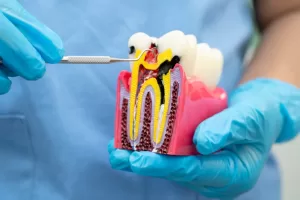Step-by-Step Veneer Procedure
Dental veneers are thin, custom-made shells typically made of porcelain or composite resin that are bonded to the front surface of teeth to improve their appearance. People choose veneers to make their smiles look better. Veneers can fix discolored, chipped, or crooked teeth and can give you a more even, attractive smile. They’re also great because they resist stains well and last a long time. Plus, getting veneers doesn’t require a lot of changes to your natural teeth, so it’s a conservative option. And the best part? You can see results right away, making your smile look better in just a few visits to the dentist. Overall, veneers are chosen because they give people the confidence to smile brightly and feel good about themselves.
Types of Veneers
There are mainly two types of veneers: porcelain veneers and composite veneers. Porcelain veneers offer superior durability, stain resistance, and a natural appearance, making them a popular choice despite their higher cost. They can last for many years with proper care. Composite veneers, while more affordable and convenient to make, may not last as long and can be prone to staining over time. However, they are a great option for those seeking a more budget-friendly solution with quick results. Ultimately, the choice between the two depends on factors like budget, desired longevity, and aesthetic preferences.
Why Should I Know About the Veneer Procedure?
Understanding the veneer procedure before getting it done is really important. It helps you make smart choices about your dental treatment and know what to expect during the process. By knowing what’s involved, you can prepare yourself mentally and physically for the appointment. Plus, it lets you talk openly with your dentist, ask questions, and make sure you’re on the same page about your goals. So, being ready beforehand helps you feel more confident and ensures a successful outcome for your smile makeover.
The Process of Getting Porcelain Veneers
Consultation: The process of getting porcelain veneers starts with a consultation with your dentist. During this appointment, you discuss your dental concerns and goals. The dentist examines your teeth to determine if veneers are a suitable option for you.
Preparation: If you decide to proceed with veneers, the next step is tooth preparation. Your dentist gently removes a thin layer of enamel from the front surface of the teeth receiving the veneers. This step creates space for the veneers and ensures a proper fit. Impressions: After tooth preparation, impressions or digital scans of your teeth are taken. These impressions serve as a blueprint for creating custom-made veneers that match the size, shape, and color of your natural teeth.
Temporary Veneers (Optional): While your permanent veneers are being fabricated in a dental laboratory, temporary veneers may be placed to protect your teeth. Once your permanent veneers are ready, your dentist carefully bonds them to your teeth using dental cement. They ensure each veneer is positioned correctly and securely bonded in place.
Veneer Placement: After the veneers are placed, your dentist makes any necessary adjustments to ensure they fit properly and blend seamlessly with your natural teeth.
Final Adjustments: Finally, you get to enjoy your enhanced smile with porcelain veneers that look and feel natural, boosting your confidence and leaving you with a renewed sense of self-assurance.
The Process of Getting Composite Veneers
Consultation: Just like the process for porcelain veneers, it all begins with a consultation with your dentist. During this visit, you discuss your dental concerns and what you hope to achieve with composite veneers. Your dentist examines your teeth to determine if composite veneers are the right choice for you.
Preparation: If you decide to move forward with composite veneers, the next step is tooth preparation. It’s important to know that in many cases, there’s no need for enamel removal in the composite veneer procedure. However, if needed, your dentist removes a minimal amount of enamel from the front surface of the teeth receiving the veneers to create space for the composite material.
Composite Layering: Following tooth preparation, your dentist applies layers of tooth-colored composite resin directly onto your teeth. They sculpt and shape the composite material to achieve the desired size, shape, and appearance of the veneers.
Curing: Once the composite material is in place, a special light is used to harden and bond it to your teeth. This process, known as curing, ensures the veneers are securely attached to your teeth.
Final Shaping: After the composite material is cured, your dentist further shapes and polishes the veneers to achieve a smooth and natural-looking finish. They make any necessary adjustments to ensure the veneers fit comfortably and blend seamlessly with your natural teeth.
The Difference Between the Process of Composite Veneers and Porcelain Veneers
The process of getting porcelain veneers typically involves more extensive tooth preparation, which may include the removal of enamel to accommodate the thickness of the veneers. This preparation is followed by multiple visits to the dentist for impressions, fabrication, and placement. Porcelain veneers are custom-made in a dental laboratory based on impressions or digital scans of the patient’s teeth. During the final placement appointment, the veneers are bonded to the teeth using dental cement. Porcelain veneers are highly durable and stain-resistant, offering a natural appearance and long-lasting results. In contrast, composite veneers require minimal tooth preparation, often without the need for enamel removal. They can be applied directly onto the teeth in a single visit to the dentist’s office. Composite veneers are sculpted and shaped chairside by the dentist using tooth-colored composite resin. Unlike porcelain veneers, there is no need for impressions or dental laboratory fabrication. The composite material is bonded to the teeth using a curing light. While composite veneers are less durable than Porcelain veneers and may require more frequent maintenance, they offer a more affordable and efficient solution for improving the appearance of teeth.

READ MORE : Emergency Dental Care At Brookdale Dentistry
Who Do I Take Care of My Veneers?
After getting veneers, regardless of whether they’re composite or porcelain, it’s essential to maintain good oral hygiene practices to ensure their longevity and appearance. Here’s how to take care of veneers:
Brush and Floss Regularly: Continue brushing your teeth at least twice a day and flossing once a day to remove plaque and food particles that can accumulate around the veneers and contribute to decay and gum disease.
Use Non-Abrasive Toothpaste: Choose non-abrasive toothpaste to avoid scratching or damaging the veneer surface. Abrasive toothpaste can dull the shine of the veneers over time.
Avoid Staining Agents: Minimize consumption of staining agents such as coffee, tea, red wine, and tobacco, as these can discolor both composite and porcelain veneers. If you do consume these substances, rinse your mouth with water afterward.
Wear a Mouthguard: If you grind or clench your teeth, consider wearing a mouthguard at night to protect your veneers from damage caused by teeth grinding.
Regular Dental Check-Ups: Visit your dentist for regular check-ups and professional cleanings to monitor the condition of your veneers and address any issues promptly.
While both composite and porcelain veneers require similar care, there are some differences in terms of maintenance. Porcelain veneers are more stain-resistant and durable than composite veneers, but they can still chip or crack if subjected to excessive force. Composite veneers may require more frequent maintenance and replacement due to their lower durability and susceptibility to staining. Ultimately, following your dentist’s recommendations for oral care and attending regular check-ups will help ensure the longevity and appearance of your veneers, regardless of the material.
Conclusion
In summary, dental veneers—whether made of porcelain or composite—are fantastic for improving the look of teeth. They’re chosen to fix various dental issues and give a more even, attractive smile. Porcelain veneers are super durable and resist stains well, while composite ones are more budget-friendly and provide quick results. Knowing about the veneer procedure helps you make smart choices and ensures a successful outcome. Both types need good oral care to stay looking good. Just brush regularly, see your dentist, and you’re good to go. Whether you go for porcelain or composite veneers, the result is a smile you’ll feel great about.
If you’re thinking about veneers, book your free consultation session with the best dentist in Toronto at Brookdale dentist. With years of experience in providing high-quality dental veneers, they are ready to help you enjoy a more beautiful smile. Additionally, if you have other dental needs, consider exploring services like Invisalign, Dental bridges, Root Canal Therapy, Sedation Dentistry, and Tooth Extraction offered by Brookdale Dentistry to maintain optimal oral health and aesthetics.



